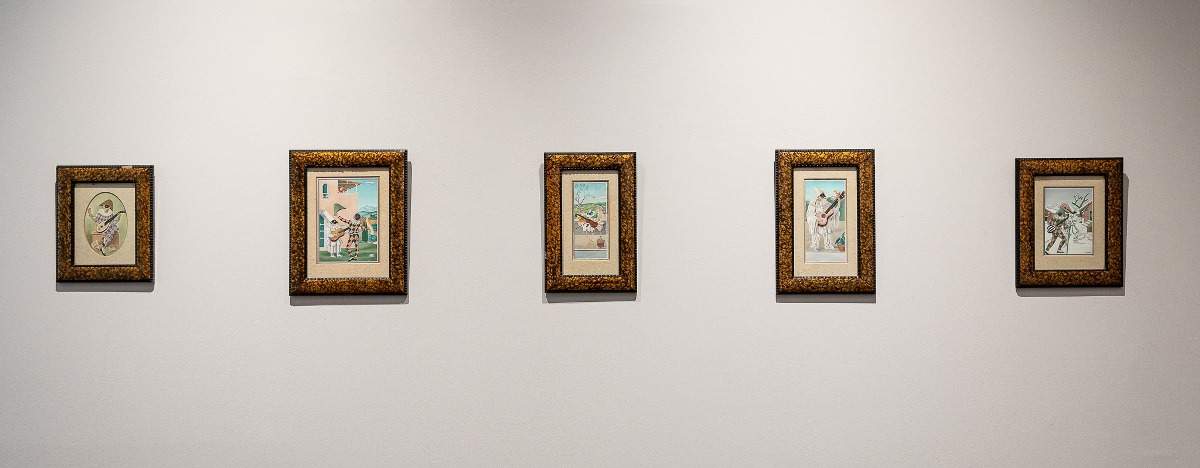Gino Severini (Cortona, 1883 - Paris, 1966) is the protagonist of the fifth appointment of Solo, an exhibition cycle at the Museo Novecento in Florence that aims to offer a concise and studied portrait of some of the great masters of the 20th century.
The exhibition, entitled Gino Severini and made possible thanks to the support of Banca Monte dei Paschi di Siena, focuses on the production dating from the 1920s and 1930s of the Tuscan artist, offering a selection of works in which the iconography of the subjects is linked to the Commedia dell’arte, theater and music. Indeed, starting in the 1920s, Severini became fascinated with the figures and stories of masks from the commedia dell’arte, such as Punchinello and Harlequin. Clowns, acrobats, and circus heroes were fascinating many artists such as Picasso, Gris, and Rouault, musicians such as Stravinsky, who had composed in 1919-1920 the neoclassical ballet Ballet avec chant Pulchinella(Musique d’après Pergolesi), and impresarios such as Djagilev. The main occasions for Severini to grapple with these themes are represented by the decoration of two private rooms: the Castello di Montegufoni, owned by Sir George Sitwell, near Florence (1921-22) and the Maison of Léonce Rosenberg, his French merchant, in Paris (1928-29).
The exhibition, housed in the museum’s second-floor rooms, brings back to Italy for the first time a selection of gouaches related to Montegufoni’s Hall of Masks, where Severini recovers the fresco tradition. The exhibition also presents four of the six panels that decorated the Rosenberg residence, in which classical landscapes rich in references to antiquity are animated by masks. Completing the exhibition are some preparatory drawings related to both decorations and several documents attesting to the research around these subjects: materials that reveal with vivid concreteness the study of geometry and the laws of proportion that guided Severini in the elaboration of forms and that will also feed the pages of Du Cubisme au classicisme (1921). The search for a stylistic purity meets the human and social vicissitudes represented by the masks, restoring a joyful yet melancholy world. These works, subsequent to the avant-garde season, are part of the trend toward a new classicism, typical of the artistic and cultural climate between the two wars, which found in Severini an attentive forerunner as witnessed by the famous Maternity of 1916, with which the exhibition opens.
Gino Severini moved to Rome at a very young age, where he met Umberto Boccioni, with whom he frequented Giacomo Balla ’s studio, approaching Divisionist technique. From 1906 he moved to Paris, alternating stays and trips to Italy. In the French capital he frequented bohemian circles and made friends with artists such as Modigliani, Braque, Picasso and Gris, and with poets and critics such as Apollinaire, Jacob and Fort.
Among the signatories of the Manifesto of Futurist Painting (1910), in 1912 he participated in the first group exhibition of the Futurists at the Bernheim-Jeune Gallery in Paris. The works of this period, close to Cubist and Futurist research, investigate the simultaneous vision of space and time, achieved by a decomposition of planes. At the outbreak of World War I he continued his research in several directions, until he arrived at the solid, classical volumes of the work Maternity (1916), shown in the exhibition. In 1921 he published Du Cubisme au classicisme, in which he anticipated the European climate of the “return to order.” These theories would also be applied in the frescoes executed in the castle of Montegufoni in 1921 on commission from Sir George Sitwell and through the intermediary of Léonce Rosenberg, his Parisian dealer. Back in Paris, he frequented the Catholic philosopher Maritain and began to devote himself to sacred themes, working on large decorative cycles. In those years he was among the exponents of the Italiens de Paris, and in Italy he participated in major events of national scope. To 1929 dates the decoration with Pulcinella and other masks for Casa Rosenberg in Paris, where he worked alongside Savinio, De Chirico and Picabia. He also devoted much time to set design, with works for the Maggio Musicale Fiorentino and La Fenice. After the war he settled in Meudon and continued his stylistic research, with a growing interest in abstraction.
For all information visit the Museo Novecento’s official website.
Source: press release
 |
| Florence, at the Museo Novecento an exhibition on Gino Severini, a great protagonist of the early 20th century |
Warning: the translation into English of the original Italian article was created using automatic tools. We undertake to review all articles, but we do not guarantee the total absence of inaccuracies in the translation due to the program. You can find the original by clicking on the ITA button. If you find any mistake,please contact us.